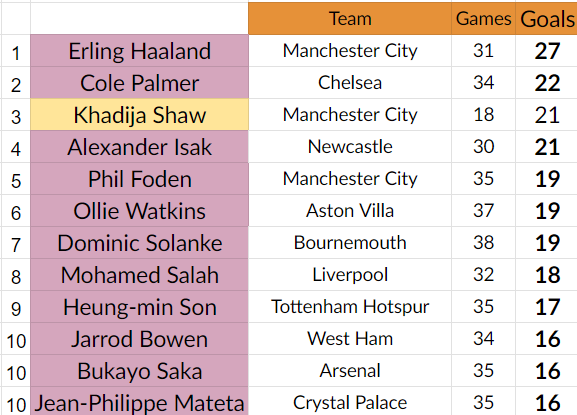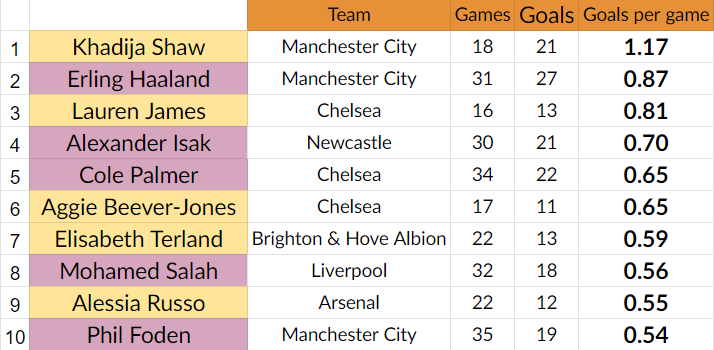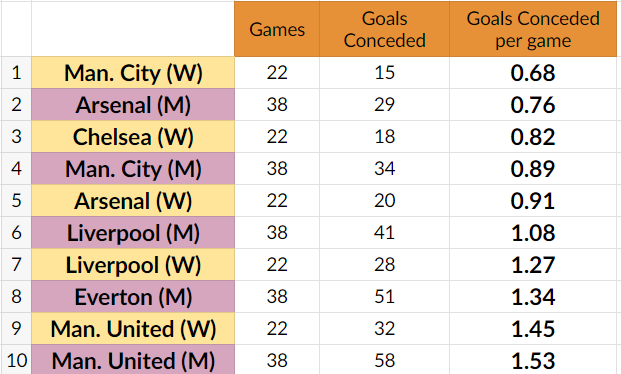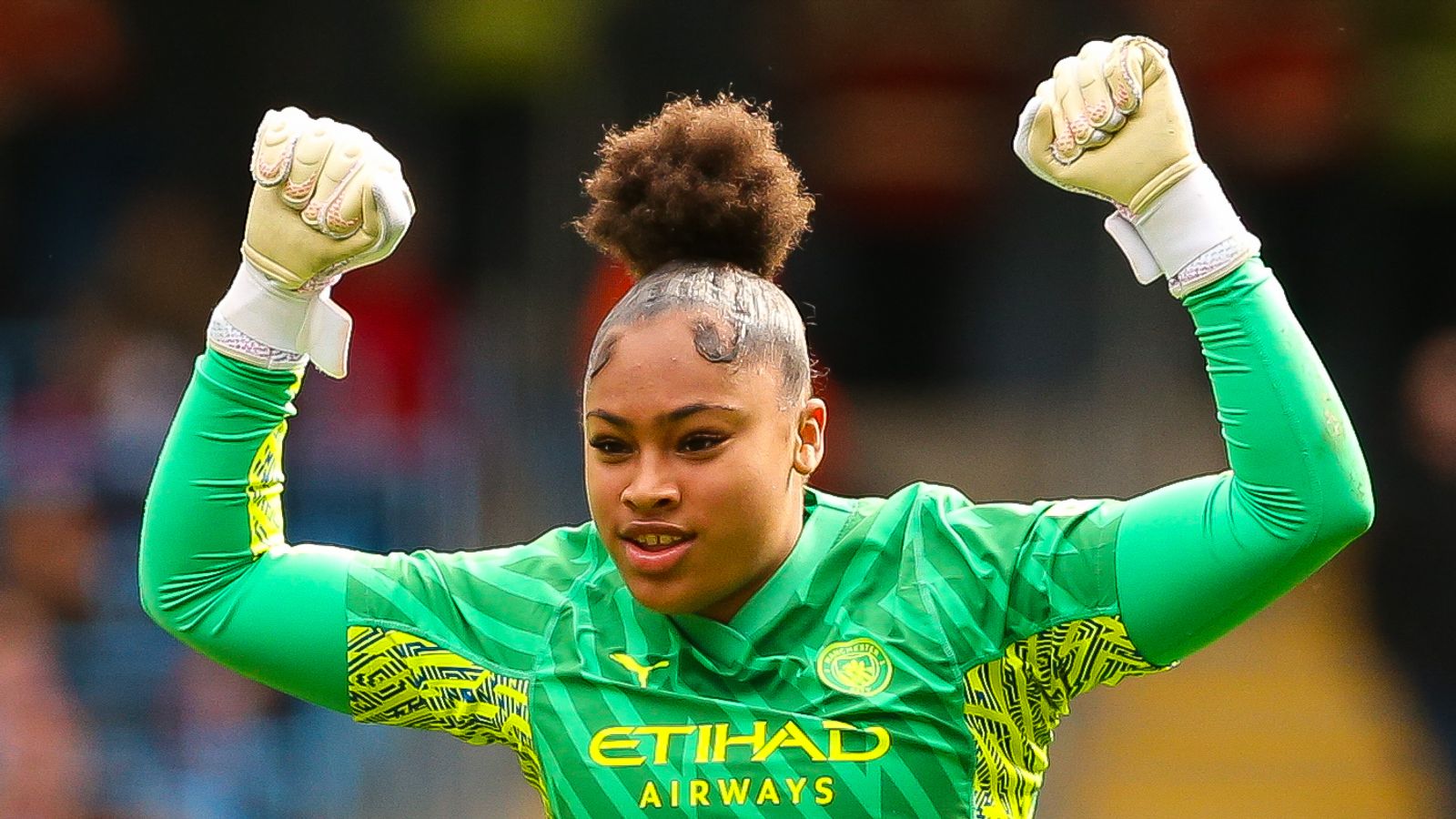The 2024/25 WSL season is kicking off this weekend and despite the ongoing exclusion of female players from all other fantasy football platforms, here at Statr we’ll be keeping a close eye on our favourite aspect of the beautiful game – the numbers. While in-depth info by player isn’t widely available, we can still take a look at the basic attacking and defending capacity of the women’s game through last season. Let’s see if we can dispel these myths about a gap in value as fantasy assets, whatever about any other gaps that exist.
The methodology is simple. We have to take a look not at overall volumes (because the men’s season is 38 games vs. the women’s 22 per year), but at efficiency in attack and defence. Return per 90 minutes, if you prefer. The core overall value of the players as fantasy assets. First up: the attackers, and we’ll be diving into the lifeblood of fantasy sports, goals scored.
Up Front

Nothing too surprising there, with Khadija “Bunny” Shaw looking a little bit lonely in representing the WSL, surrounded by familiar names and finishing behind only Chelsea’s Cole Palmer and… that guy… for putting the ball in the net the most times last season. An outstanding achievement for any player, but doing so in two thirds of a season makes it all the more impressive.

So let us now see what happens when we factor in the differing number of games played across the season. And yes, the detractors will point out that a lower workload makes for fewer injuries, sure. But that’s also true for the defence these players are trying to overcome.

Shaw once again dominant, this time outperforming he-who-shall-not-be-admired by a factor of almost half. If she could translate this to a full 38 games, this would be the equivalent of a male player landing a mind-blowing 44 goals in a premier league season. The current record , set by (sigh, fine) Erling Haaland, is 36 in the 2023/24 season. Further down the list we see appearances from Lauren James and Aggie Beever-Jones, who helped lead Chelsea to the WSL title last year, as well as Elisabeth Terland whose performances for the mighty Seagulls last season have brought her to Old Trafford this year . And look who doesn’t make the top ten: Watkins, Solanke, or Saka, all three considered must-have assets at some stage of last season. All told, the women comprise exactly 50% of the top ten most effictive converters of games played into goals scored.
Out Back
The predictable reply to this, from those who would insist that there’s a gap in quality, is that the defences in the WSL are probably weaker or something like that. No hassle, let’s check the numbers. Because of limited specific player stats for the WSL (for now…watch this space), we’ll use the team goals conceded metric. After all, if the WSL defenders and goalies aren’t providing any challenge to get past, it must be easier for the Shaws and Jameses to score, right?
Wrong.

Again, there’s that 50/50 split in performance, with a WSL team out on top. While nobody’s really managing to keep out goals in a consistent manner any more, as we’ve discussed elsewhere, the City, Chelsea and Arsenal WSL teams are actually outperforming most men’s teams in terms of keeping the opposition out of their net. And yes, it’s objectively hilarious that Everton’s men’s team are one of the tightest defensively in last year’s PL and still managed to finish 15th (or 14th, if it weren’t for those pesky points deductions).

So…are you saying the WSL is better than the FPL?
Absolutely not. Not even close. Women’s football is not yet at the same standard as the men’s game, nor is it likely to ever be thanks in no small part to love that Premier League Infinite Money Machine. As well as this, the WSL is still in relative infancy, with significantly lower investment and smaller audience than the men’s game. As time goes on, that gap is likely to close, particularly given the exploding interest in the women’s game.
But we’re not here to talk football, not really. We’re here to talk fantasy football, wherein the stats are the game and the game is the stats. From the above, it’s clear that there are numerous outstanding assets in the women’s game, who will do exactly what every drafting coach wants their squad to do: score points week in, week out, and outshine their rival squads. If the attackers are bagging goals, and the defences are keeping them out, what you’ve got on the menu is a whole new pool of players to add variety and choice to the fantasy football experience.
If only there were a fantasy platform that let you draft WSL players, eh? In unrelated news, if you like that idea then why not join our mailing list as we continue to develop the most in-depth and inclusive fantasy football game the world has ever seen.
Jimi Kavanagh




Comments are closed